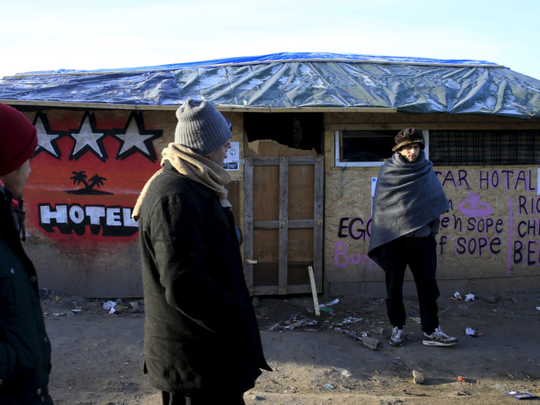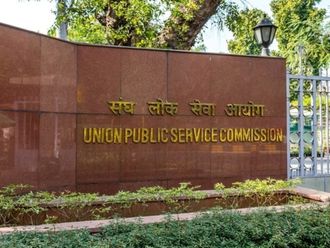
You don’t need to have a home to be “evicted”. You can be evicted from a tent in the ‘Jungle’ — the refugee camp in Calais. You may have seen the pictures: Mud, fires, rubbish. A landscape of futility. The French police in riot gear went in before dawn to dismantle this “shanty town” and move 1,500 of its inhabitants into alternative accommodation.
The French authorities flattened and destroyed the scrappy tents. This clearance was said, as always, to be about improving the conditions of the refugees living there. The new accommodation on which the French have spent £20 million (Dh105.14 million) is shipping containers, each kitted out with 12 bunk beds. There is heating and electricity. This is surely better than where they are now. Why then were these people so reluctant to go? Well, partly because the rows of containers look like a detention centre. They think it’s a jail. And partly because there are few communal facilities. The ‘Jungle’ has sprigs of communal life everywhere you go. It’s a desperate, dangerous place, but people get together to eat. Or to pray. Or to trade information and whatever else they can. The mistrust of what the French are doing is deep. And understandable.
When I was there in November, one of the many haunting things I saw were pictures that some of the refugees had drawn. You would expect them to draw some of the awful experiences they have burnt on their vision and they do: Bombings, murders, executions and boats sinking. But many draw pictures of more recent brutalisation. Of tear gas and rubber bullets used by the French police. The hostility they face in France is but one of the reasons they remain so determined to get to England.
‘Forcible relocation’
I heard several reports of “forcible relocation” happening in the smaller settlements that have been broken up by the police, with refugees being taken to centres of “welcoming”. There is no question that the French want to close the Jungle. Or drastically reduce its size to 2,000. There are those who would happily go in and demolish the tents with the people inside them. The only thing that is really stopping them is the presence of volunteers who helped move everyone peacefully.
There is no doubt either that its inhabitants need better conditions, but what is the endpoint? I have never seen anything like the Dunkirk camp Grande-Synthe, which I called the border of hell. There is nothing there but mud and chaos and it is ringed by traffickers. No water, no electricity, freezing cold children huddled around fires, coughing. No basic humanitarian standards are met at all. On January 11 Medecins Sans Frontieres started work on a new camp because it was so bad. The director of MSF (Medecins Sans Frontieres, or Doctors Without Borders), Vickie Hawkins, described the conditions there as “some of the worst I have seen in 20 years of humanitarian work”.
God knows, these people need help. Plastic sheeting to reinforce their tents. Paracetamol to ease their pain. But the situation has deteriorated because of the central idea that Calais cannot be a magnet, and most of all, France cannot be a magnet. The fact is France is a magnet, and thinking: “Let refugees fester so that more don’t come” goes nowhere and allows the traffickers to flourish. Indeed, many refugees have an idealised view of England because the traffickers have sold it to them. Once they have got so near, they are unlikely to give up, and are prepared to die trying. Having seen how they live, I can see how little they have to lose as they walk to the tunnel or port, time and time again.
‘David Cameron Street’
And time and time again, the camps around Calais have been bulldozed. Sangatte run by the Red Cross closed in 2002. The Jungle has regularly been subject to “clearances” often in front of journalists and volunteers. The underlying political problem is never dealt with, except ironically by the refugees and migrants themselves, who have put up a sign saying “David Cameron Street” in the ‘Jungle’.
There was never a proper infrastructure to replace Sangatte, as there has never been an acceptable policy between the British and French. There is a humanitarian crisis at the doorstep, herding people into shipping containers. Better living conditions means destroying a fragile community because no one wants to say how permanent this accommodation is. But then no one wants to say these are people. They are detritus to be cleared away.
The political conversation is of brave Kurds fighting Daesh (the self-proclaimed Islamic State of Iraq and the Levant); the reality is of Kurdish families trying to keep their children warm by sleeping in a swamp just across the Channel. France will take Syrians, but not the ones who have made it to Calais. Most of all, there is the repeated and failing mantra that this hellhole must act as a deterrent.
I don’t suppose there are many votes for British Prime Minister David Cameron in doing much about this disaster, except maybe a sense of what Europe might be. Why is France prepared to let thousands live in conditions that don’t meet the standards of the refugee camps in Jordan and Lebanon? This utter failure of joined-up thinking plays out in the rhetoric around refugees. Humanity is bulldozed away. All that’s protected is a Banksy mural, carefully covered up.
— Guardian News & Media Ltd








